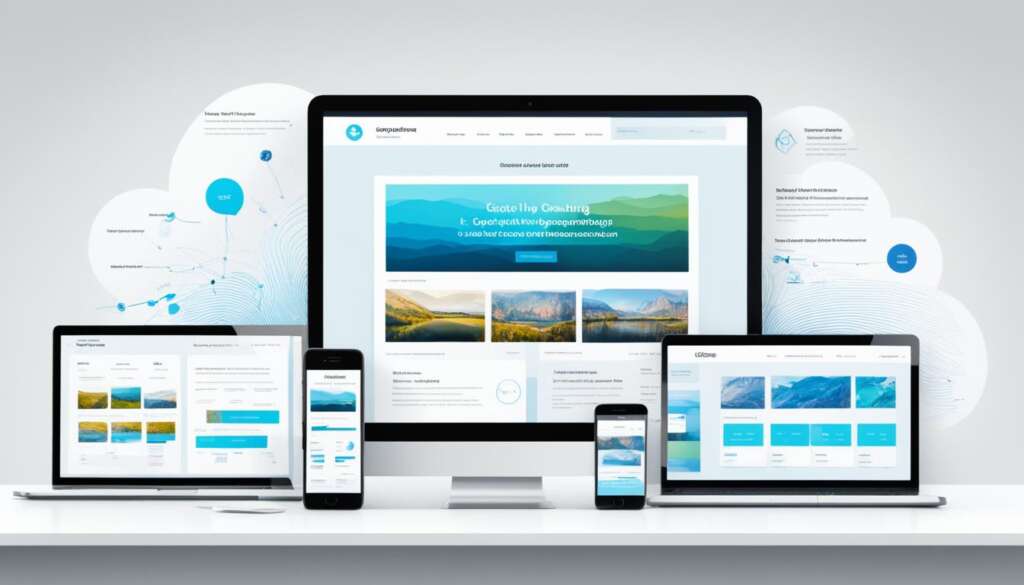Table of Contents
In today’s digital era, the symbiotic relationship between SEO and web development is crucial for online success. SEO focuses on enhancing a website’s visibility on search engine results pages (SERPs), while web development aims to create functional and user-friendly digital experiences. Responsive design is a fundamental aspect of modern web development, ensuring that websites adapt seamlessly to various screen sizes and devices. This integration of SEO and web development highlights the importance of collaboration between the two disciplines in today’s competitive landscape.
The Impact of Responsive Design on SEO
Responsive design significantly impacts SEO in several ways. Firstly, it plays a crucial role in mobile optimization, as more users are browsing the internet on mobile devices. Search engines prioritize mobile-friendly websites, making it essential for sites to provide a seamless user experience across different devices.
“Responsive design ensures that websites adapt seamlessly to different devices, enhancing the user experience and improving SEO performance.”
Responsive design also improves site speed, another essential ranking factor in SEO. A fast-loading site leads to better user experience, increased engagement, and higher rankings.
Additionally, responsive design reduces bounce rates by providing a user-friendly interface, improving the chances of visitors interacting further with the website and positively influencing SEO rankings.
Mobile Optimization and SEO
As mobile devices become the preferred mode of browsing the web, mobile optimization has become a critical factor in SEO. Responsive design ensures that websites are optimized for mobile devices, allowing users to access content and navigate websites seamlessly. By prioritizing mobile optimization, businesses can improve their search engine rankings and attract more organic traffic.
Site Speed and User Experience
Site speed is a crucial element in user experience and SEO. Responsive design optimizes website performance by eliminating unnecessary elements and optimizing image sizes, resulting in faster loading times. A fast-loading website not only ensures a positive user experience but also helps improve SEO rankings as search engines prioritize sites that offer a seamless and efficient browsing experience.
“A fast-loading site leads to better user experience, increased engagement, and higher rankings.”
Reducing Bounce Rates with User-Friendly Design
Responsive design plays a vital role in reducing bounce rates. When a website provides a user-friendly interface that adapts effectively to various devices, visitors are more likely to stay on the page and explore further. This improved user experience reduces bounce rates, positively impacting SEO rankings.
By embracing responsive design, businesses can optimize their websites for mobile devices, improve site speed, enhance user experience, and reduce bounce rates. These factors contribute to higher search engine rankings, increased organic traffic, and ultimately, online success.
Enhancing User Experience through Responsive Design
User experience enhancements through responsive design have a significant impact on SEO. Responsive design ensures that websites are easy to navigate and interact with on different devices, leading to longer user sessions, increased page views, and higher engagement.
These positive user behaviors are signals to search engines that the website is valuable, resulting in improved SERP rankings. Additionally, responsive design improves content accessibility, as users can seamlessly access and engage with the content across various devices. The consistent user experience offered by responsive design contributes to better SEO outcomes.
“Responsive design ensures that websites are easy to navigate and interact with on different devices, leading to longer user sessions, increased page views, and higher engagement.”
One of the key benefits of responsive design is its ability to enhance website navigation. With responsive design, menus, buttons, and other interactive elements adjust to fit the screen size, making them easily clickable and accessible on both desktop and mobile devices. This improves the overall user experience and encourages users to explore further, resulting in longer sessions and increased page views.
Enhancing Content Accessibility
Another significant advantage of responsive design is improved content accessibility. With responsive design, the same content is available across all devices, ensuring that users can seamlessly access and engage with the information they need, regardless of the device they are using. This not only improves user satisfaction but also contributes to improved SEO rankings.
- Responsive design removes the need for separate mobile versions of websites, reducing the risk of duplicate content, which can negatively impact SEO.
- By presenting the same content across all devices, responsive design ensures that search engines can crawl and index the website efficiently, improving visibility in search engine results pages (SERPs).
- Responsive design also allows for easy sharing of content, as users can share the same URL regardless of the device they are using. This increases the potential reach and visibility of the content, positively influencing SERP rankings.
Improving SERP Rankings
The combination of enhanced user experience and improved content accessibility provided by responsive design leads to improved SERP rankings. When users have a positive experience on a website, spend more time engaging with the content, and view more pages, search engines interpret this as a sign of quality and relevance.
Responsive design also ensures that users do not encounter any barriers or frustrations when accessing a website. It eliminates the need for pinching and zooming, scrolling horizontally, or encountering distorted layouts on mobile devices. This seamless and consistent experience across different devices contributes to higher user satisfaction and engagement, ultimately impacting SERP rankings positively.
Summary
By prioritizing user experience enhancements through responsive design, website owners can create a seamless and accessible browsing experience for their visitors. The improved website navigation, content accessibility, and consistent user experience offered by responsive design not only enhance user satisfaction but also contribute to improved SERP rankings. In today’s competitive online landscape, responsive design is a crucial factor for businesses aiming to improve their SEO performance and achieve online success.
Reducing Bounce Rates with Responsive Design
Responsive design plays a crucial role in reducing bounce rates. When a website adapts effectively to different screen sizes and devices, users are more likely to stay on the page and explore further. This is particularly important in a mobile-dominated landscape, where a poor mobile experience can lead to high bounce rates.
Google’s algorithms take bounce rate into consideration when ranking websites, making responsive design essential for maintaining a strong online presence and attracting user engagement.
| Benefits of Responsive Design in Reducing Bounce Rates | |
|---|---|
| 1. Improved User-Friendly Interface: | Responsive design ensures a seamless and user-friendly interface across devices, making it easier for visitors to navigate and engage with the website. |
| 2. Enhanced Mobile Experience: | With the increasing use of mobile devices, responsive design optimizes the website for a mobile experience, minimizing usability issues that may lead to high bounce rates. |
| 3. Consistent User Experience: | Responsive design provides a consistent and cohesive user experience, regardless of the device used. This encourages users to explore the website further, reducing the likelihood of bouncing. |
| 4. Engaging Visual Presentation: | By ensuring that the website’s design and content are visually appealing and responsive, users are more likely to be captivated and spend more time on the site, decreasing bounce rates. |
By incorporating responsive design principles, websites can create an engaging and user-friendly experience that caters to the diverse needs of online visitors. This not only reduces bounce rates but also improves overall user satisfaction and SEO performance.
The Predictive SEO Benefits of Responsive Design
Responsive design offers numerous predictive SEO benefits. It aligns with the growing trend of mobile usage, ensuring websites are optimized for mobile devices. This mobile optimization is crucial for maintaining search engine rankings, as search engines prioritize mobile-friendly sites.
In addition to mobile optimization, responsive design enhances site speed, a vital factor in SEO. By optimizing images, eliminating non-essential elements, and utilizing clean coding practices, responsive design improves the loading speed of websites. A fast-loading website not only provides a better user experience but also increases the likelihood of users staying longer on the site.
Furthermore, responsive design reduces bounce rates by providing a user-friendly interface. When websites adapt seamlessly to different screen sizes and devices, users are more likely to engage and explore further. This positive user experience contributes to lower bounce rates, which can lead to improved SEO rankings.
By implementing responsive design, businesses can harness its predictive SEO benefits, including mobile optimization, enhanced site speed, improved user experience, and lower bounce rates. These advantages result in better search engine rankings, increased visibility, and ultimately, online success.
The Impact of Responsive Design
Responsive design ensures that websites adapt seamlessly to different screen sizes and devices.
| Benefit | Description |
|---|---|
| Mobile Optimization | Responsive design optimizes websites for mobile devices, aligning with the growing mobile usage trend. |
| Site Speed | By optimizing images, eliminating non-essential elements, and utilizing clean coding practices, responsive design improves site loading speed. |
| User Experience | Responsive design provides a user-friendly interface, enhancing the overall user experience. |
| Lower Bounce Rates | When websites adapt effectively to different devices, users are more likely to stay on the page and explore further, resulting in lower bounce rates. |
Conclusion
In conclusion, the intersection of responsive design and web performance is a critical aspect of SEO and online success. The implementation of responsive design ensures that websites adapt seamlessly to different devices, providing an optimal user experience and improving overall SEO performance.
By prioritizing responsive design, businesses can optimize their websites for performance, user satisfaction, and search engine rankings. This includes areas such as mobile optimization, site speed, user experience enhancements, and reducing bounce rates.
Responsive design not only enhances mobile optimization, but also improves site speed, reducing loading times and increasing user engagement. By creating a user-friendly interface that performs well on different devices, bounce rates are minimized, ensuring visitors stay on the website longer, further positively impacting SEO rankings.
Incorporating responsive design into web development strategies is crucial in today’s digital landscape. By doing so, businesses can achieve sustainable growth, increase their online visibility, and gain a competitive advantage over their peers.
FAQ
What is responsive design?
Responsive design is an approach in web development that ensures websites adapt seamlessly to various screen sizes and devices, providing a consistent user experience.
How does responsive design impact SEO?
Responsive design significantly impacts SEO by improving mobile optimization, site speed, user experience, and reducing bounce rates, all of which are important ranking factors for search engines.
What are the user experience enhancements provided by responsive design?
Responsive design enhances user experience by making websites easy to navigate and interact with on different devices, leading to longer user sessions, increased page views, and higher engagement.
How does responsive design reduce bounce rates?
Responsive design reduces bounce rates by providing a user-friendly interface that adapts effectively to different screen sizes and devices, encouraging users to stay on the page and explore further.
What are the predictive SEO benefits of responsive design?
Responsive design aligns with the growing trend of mobile usage, enhances site speed, improves user experience, and reduces bounce rates, all of which contribute to better SEO rankings and performance.













